A Step-by-Step Guide to How I Do Content Research
I love to do content research — what’s more satisfying than falling down a few Google rabbit holes? (Don’t answer that.)
Of course, great marketing content is built on more than just Google search results. I’ve put together a six-step guide to how I do my own content research for HubSpot blog posts using a real-life example.
Table of Contents
- What is content research?
- Why is content research important?
- Components of Content Research
- How to Do Content Research
On the one hand, content research is exactly what it sounds like — researching content. But it’s a deceptively simple term for a process that’s a lot more complex than a few Google searches.
Put into marketing terms, content research is the systematic process of gathering information to create valuable content that meets your readers’ needs, furthers your business goals, and ranks in search results.
Why is content research important?
Thoughtful and thorough research will reward you with compelling, engaging, and genuinely helpful content. You’re probably already doing keyword research (if not, learn the basics!), and you probably already know subject-matter experts in your company or network. Content research will connect all these points together.
And “genuinely helpful” cannot be understated. If you understand search intent and can answer your users’ questions, you’re establishing your brand as an authority, setting yourself up for return visitors, and showing Google that you know your stuff.
Having a structured research plan will help with other aspects of your content workflow, like a marketing calendar or editorial calendar, content intelligence, and any other tools you and your team use to maintain a well-oiled marketing machine.
Components of Content Research
Although the sub-steps of content marketing research may look a little different depending on your project and field — we’ll get into that in the next section — there are a few basics that are foundational to great content.
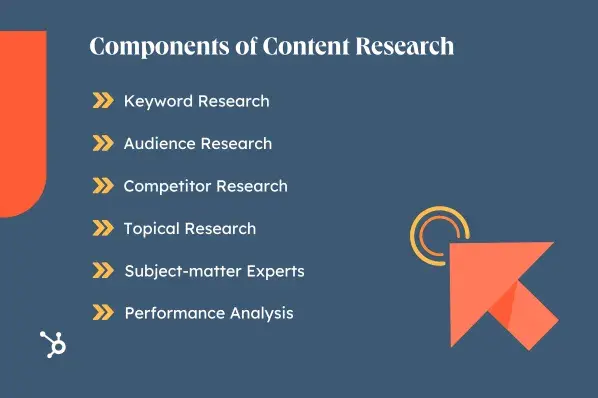
Keyword Research
Begin at the beginning, as they say. Keyword research is the gateway to analyzing search intent that answers not just your users’ initial questions, but also their follow-up questions (and maybe even questions they didn’t know they had).
You can check out our beginner’s guide to keyword research, but here are the main elements to keep in mind:
- Relevance: Your content will only rank for a keyword if it meets the searchers’ needs.
- Authority: Google provides more weight to sources it deems authoritative.
- Volume: Volume is measured by MSV (monthly search volume), which means the number of times the keyword is searched per month across all audiences.
Audience Research
You probably already know who your target audience is, and you may even have customer or buyer personas. Also consider search intent and follow-up questions.
If I’m writing marketing content about bedding, let’s say, there’ll be a substantial difference in the audience for budget bedding versus luxury bedding. For the former, I might be looking for subject-matter experts on different kinds of materials, including less expensive options. If I’m marketing luxury bedding, I might look for experts on the highest-quality materials and construction methods.
Whoever your audience is, keep those personas in front of you as you conduct the rest of your research so you don’t find yourself down the wrong rabbit hole.
For a deeper dive into market research, including a how-to guide, check out our market research guide and templates.
Competitor Research
You’ll likely turn up some competitors as you do your keyword research. I like the Ahrefs tool that compares two sites so you can see what one has that the other doesn’t — this can be super useful if you’re comparing a top-ranking competitor with one that ranks a bit lower. What sets the number one apart from the rest?
Continuing with luxury bedding, here’s what Ahrefs’ keyword explorer looks like:
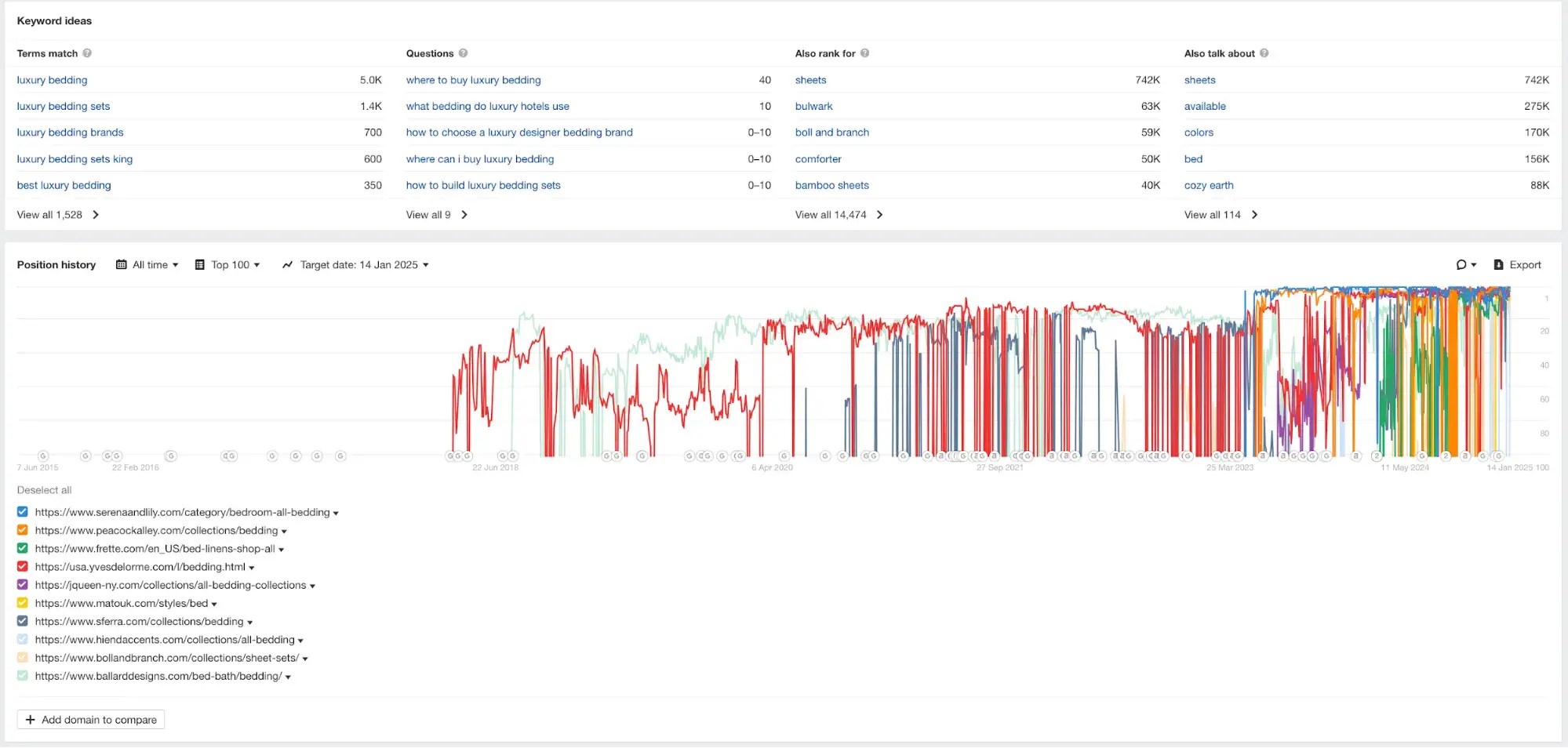
I want to see what the top-ranked result has that the 10th result doesn’t. In the Competitive Analysis tab, I can input both of those URLs, like so:
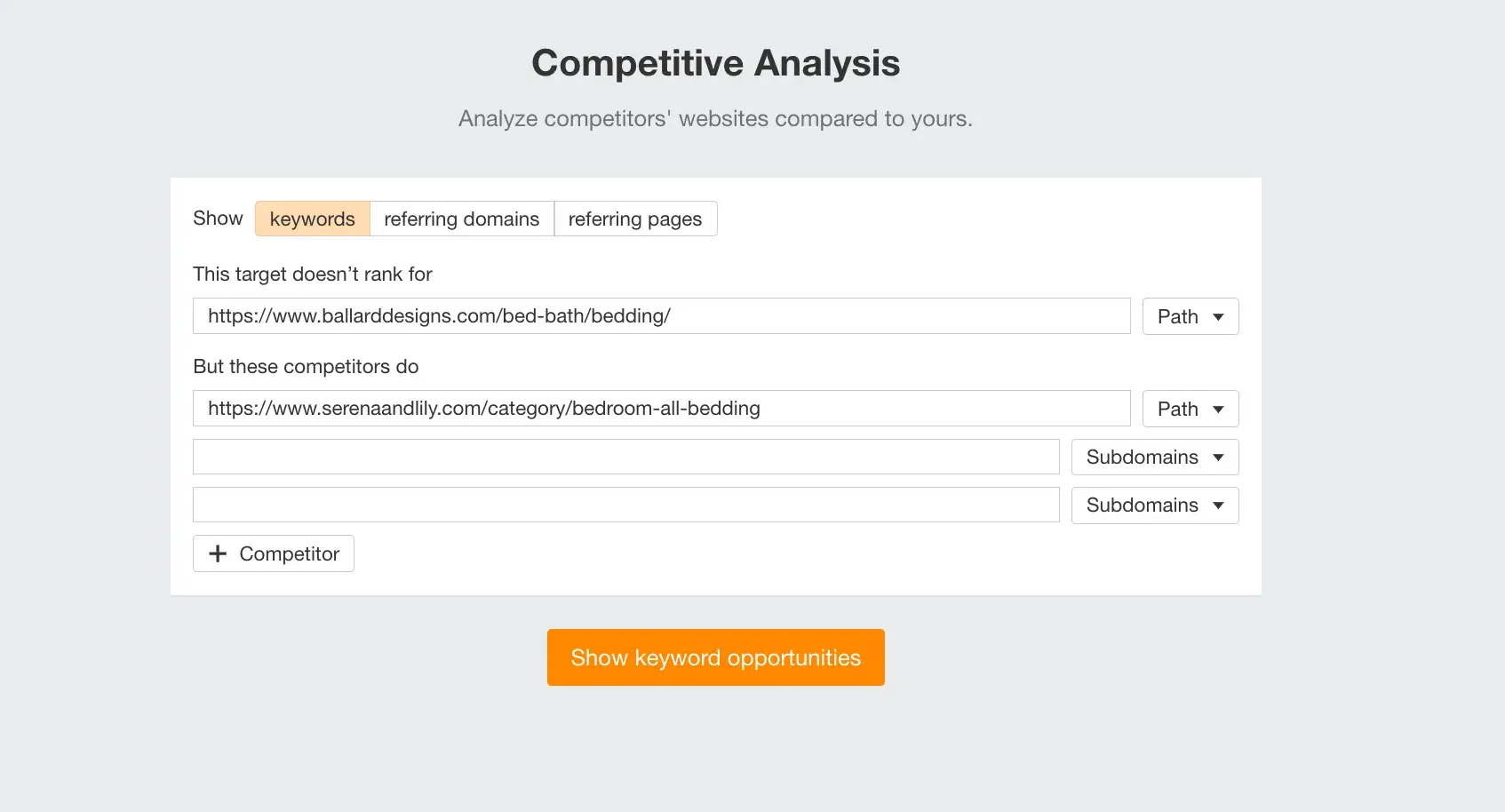
When I hit “Show keyword opportunities,” I can see what the top-ranked link has that the 10th-ranked link doesn’t:
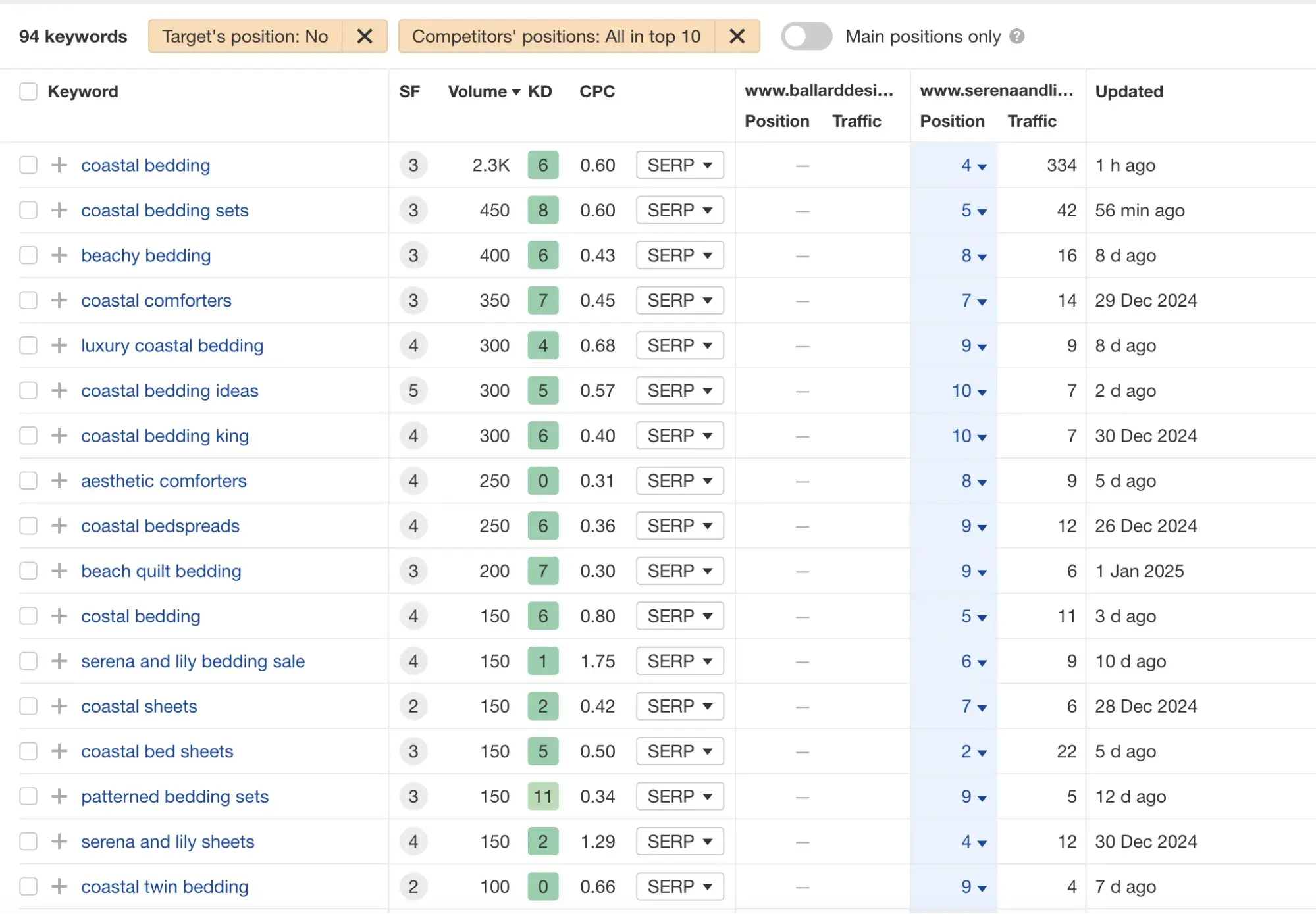
I confess I don’t know exactly what “coastal bedding” is, but the top-ranked link has a lot of it. Knowing where my competitors are killing it will help me think about the search intent of my target audience.
Start thinking about what you bring to the table in terms of your own experience, knowledge, and network. What holes in search intent might you be able to fill?
Topical Research
Whether you start on Google or an AI-powered search engine, make sure that you’re careful about your sources. Are they websites or publications that you know and trust? What info can you find about the author in their bio or on LinkedIn?
(Random pro tip that hopefully you’ll never need, but: If something seems too good to be true, check and make sure it’s not dated April 1. I know more than one smart writer who’s fallen for a brand’s April Fools’ joke.)
A few starting points I’ve relied on in my own research:
- Search LinkedIn for your keywords. Oftentimes, I’ll find experts and thought leaders talking about exactly what I’m writing about. Just be sure that you cite and link to them if you use their writing as a source.
Pro tip: Do your due diligence — read the person’s LinkedIn profile and make sure you can trust their expertise.
- Search Google Scholar. Even though the results might be too academic for your audience, this has helped me locate experts and find the newest research, especially when AI is involved.
Pro tip: Check the publication date or restrict your search to the last couple years, unless you’re looking for historical knowledge. For studies, make sure you understand the sample size and the geographical location — they might be quite different to your own target audience, so proceed with caution.
- Post on your own LinkedIn. If you have a sizable following and/or a strong network in your industry, letting other content managers know that you’re working on a piece can surface some experts you may already know. Your network might also have suggestions for other people or resources.
- Use primary sources. If you have a subscription to Statista or a similar service, you can usually find a treasure trove of studies that are directly relevant to your topic.
Pro tip: Don’t rely on other articles that cite studies — I’ve found that these are often old studies, even if the article has a recent date.
- Use social media. Even if you don’t have access to social media listening tools, you can still dig into places like Reddit, Quora, Substack, or niche online forums where people in your industry gather and talk.
- Use your co-workers. If you don’t already have a Slack or Teams channel where your fellow marketers can bounce ideas off each other or ask questions, consider this a sign to start one. Your colleagues may be experts themselves, or they may be able to connect you with somebody from their network.
Subject-matter Experts
Not everything you write requires a subject-matter expert, but getting an outside perspective on a topic can give you ideas and creative inspiration, and expert quotes are good for your readers and good for search algorithms that prioritize personal experience.
Quotes and background information from the people in the trenches will also distinguish your final product from AI-written content. I like to keep these informational interviews to just 15 minutes — it’s long enough to get some solid background info and quotes, and short enough that it’s easy for even busy people to say “yes” to.
Performance Analysis
You’re not quite done when you hit “publish.” Take some time to review your KPIs to see how the content resonated with your audience, and whether there’s anything you should consider editing now or revising in the future.
KPIs that you might include in your analysis:
- Engagement metrics like scroll depth, click-through rates, and bounce rates
- Traffic metrics like page views, unique visitors, and return visitors
- Conversion metrics like lead generation rates, product purchases, and email signups
If you have the resources to do at least a light monthly performance analysis of all your content, patterns will emerge, and you’ll be able to further refine SEO, E-E-A-T, voice and tone, and other elements that make your content distinct.
How to Do Content Research
Let’s use a piece I wrote recently about B2B newsletters as an example. It’s a topic I have experience with, but I wouldn’t consider myself an expert, per se.
Here’s how I conducted my content research:
1. Research keywords and audience intent.
Thanks to our crack SEO team, I know that the primary keyword for this article is “B2B newsletter marketing,” so my first step is to use Ahrefs’ keyword explorer:
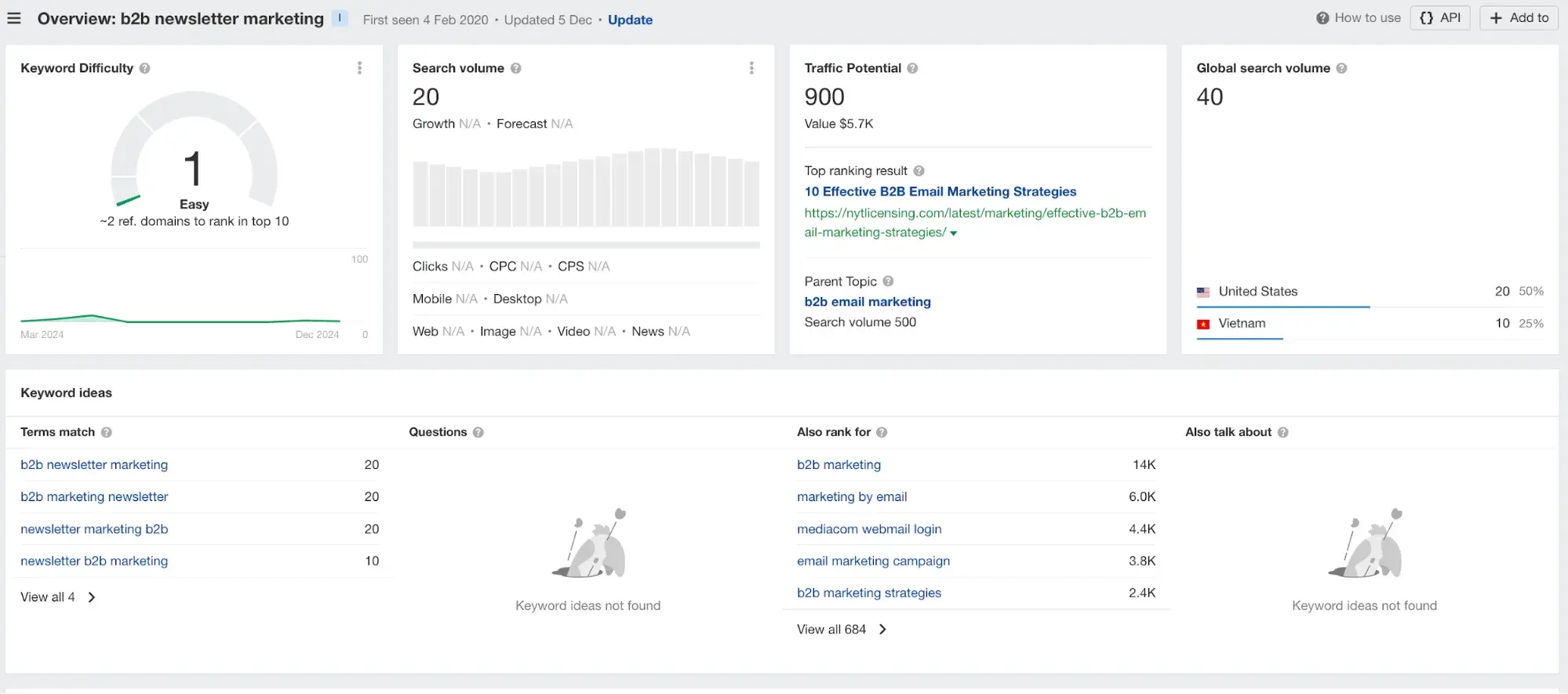
I can also narrow my search by user intent by selecting the dropdown menu and ticking the “intent” box.
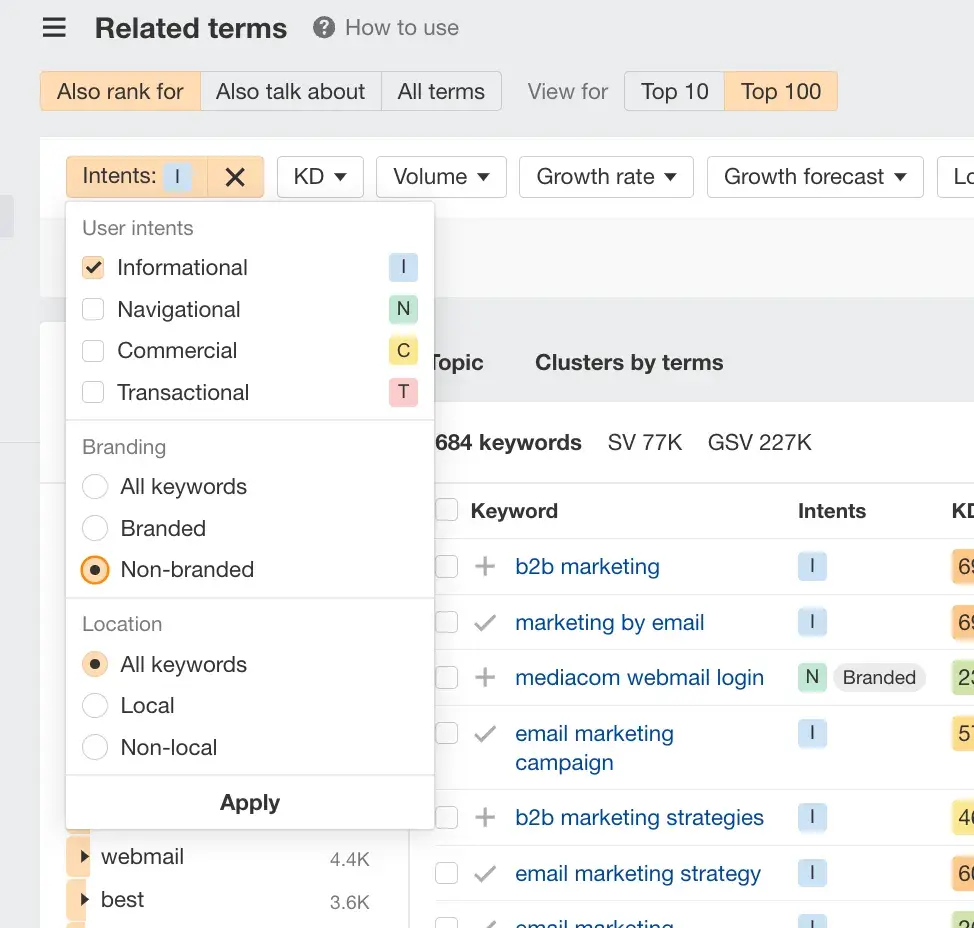
A few things I’m noticing in these results: strategies, examples, and best practices. This gives me an idea of what users are looking for, and it will help me structure my article to make sure it delivers real value.
People Also Ask
On Google, I searched for “B2B newsletter marketing” and scrolled down to the People Also Ask section.
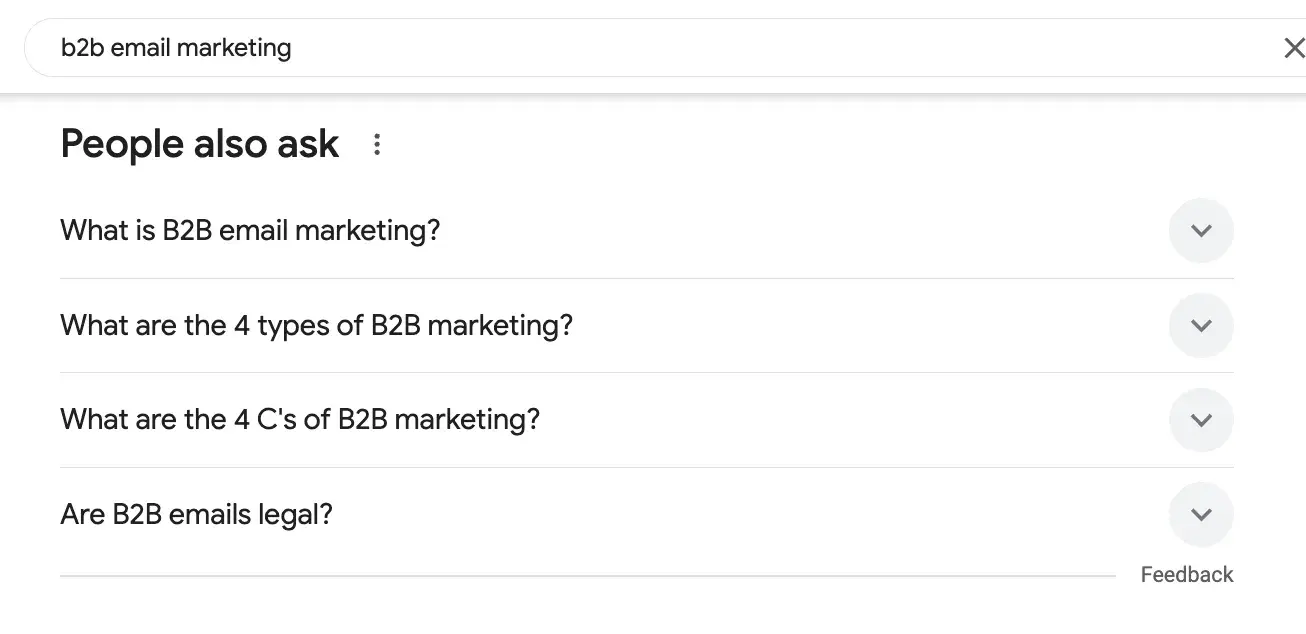
It’s more of the same — users want an overview of what B2B newsletter marketing is and what best practices are.
Ahrefs also has a handy SERPs overview with the same info:
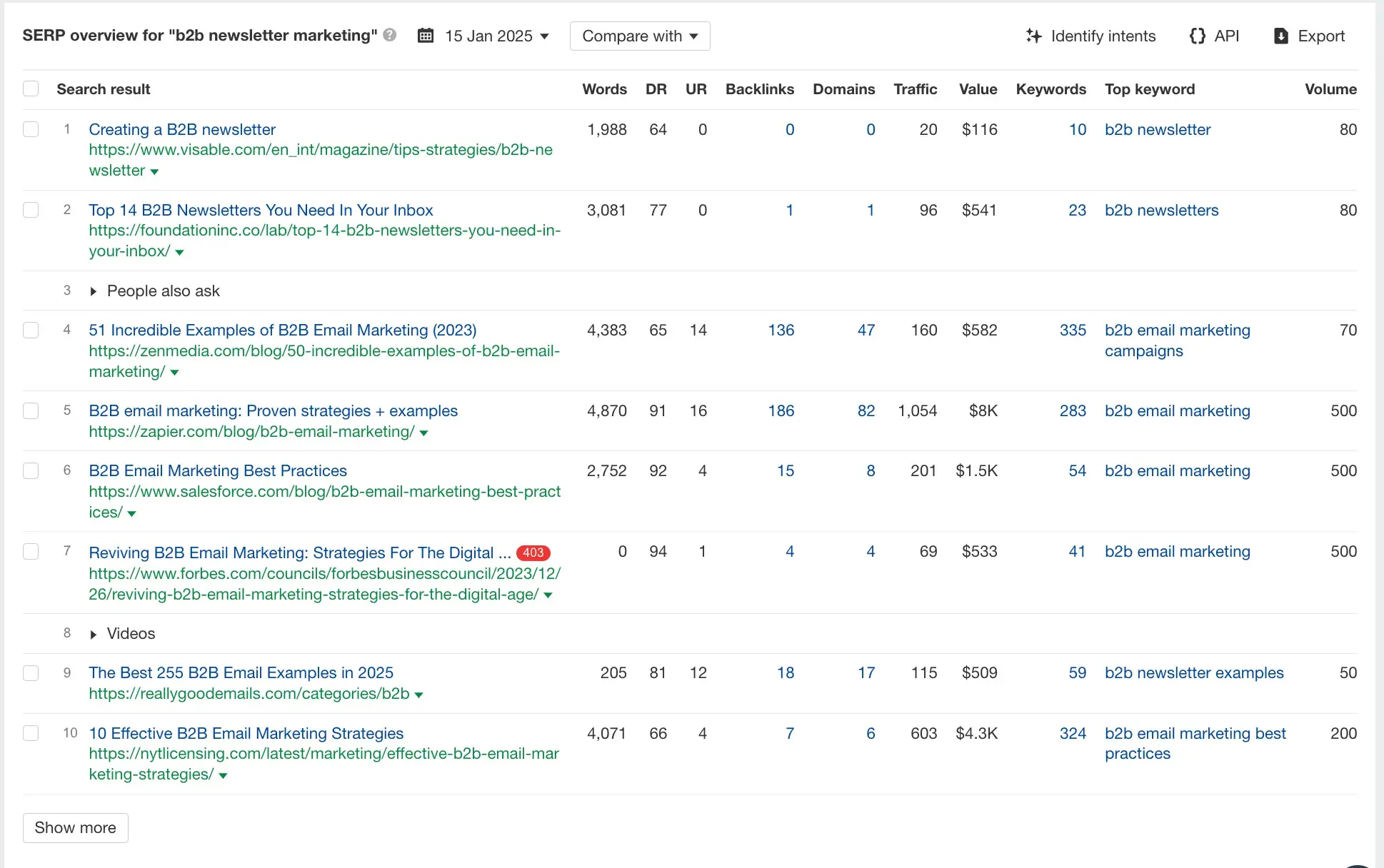
AI Search Engines
I personally don’t like to use AI for outlines or first drafts, but I do like it for content research. I often use Perplexity for research and Claude for analysis; together they can help me identify a perspective I hadn’t considered or uncover more resources.
When I search Perplexity for “B2B newsletter marketing,” I can scroll down to the Related Questions section:
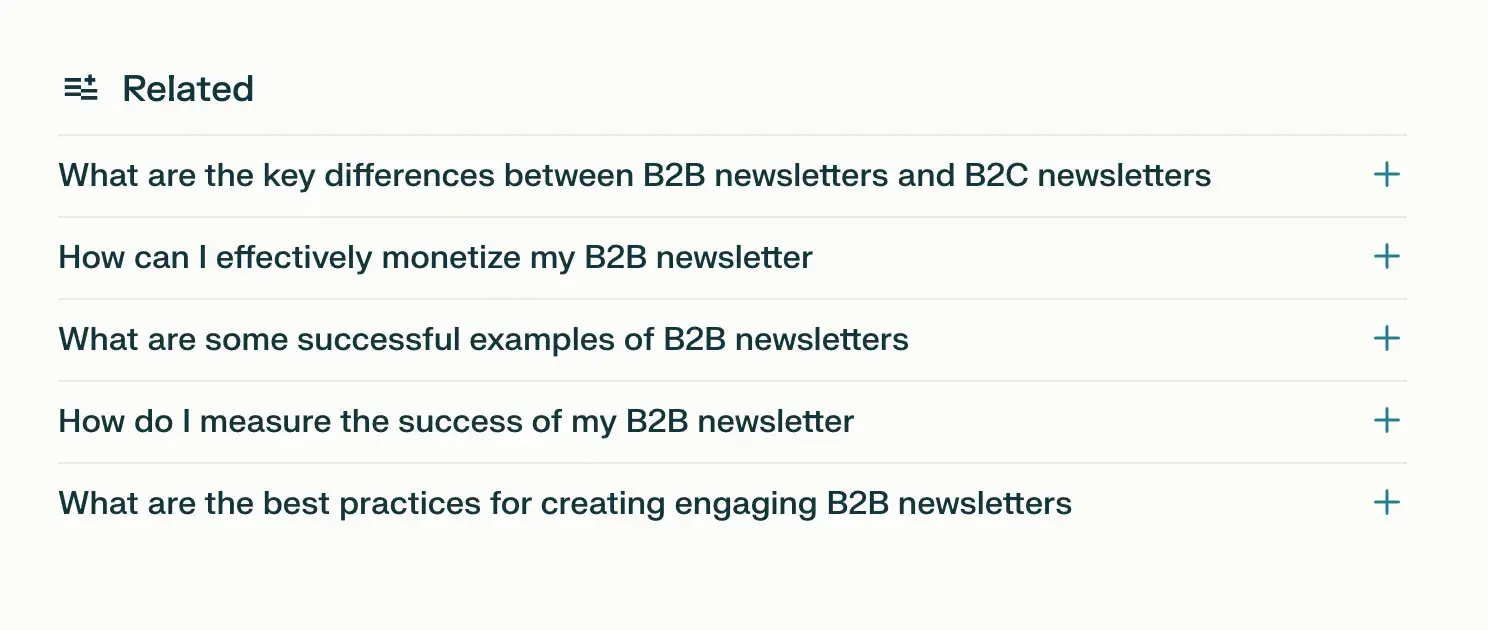
No surprises here — more confirmation that users are searching for an overview, best practices, and examples.
2. Research the competition.
I use both Ahrefs and Perplexity to identify competitors.
Perplexity synthesizes info from its top sources, so I want to see what it’s identified as a source. I just use a simple search term for this rather than a complex engineered prompt:

This shows me three sources; click on the box that says “Show all” to see all the sources it’s pulling from.

This reveals all the sources and its links, which gives me an idea of the competition.
In Ahrefs, I can skim through the list of the top-ranking articles that rank for the same keyword I’m targeting.

One important note at this step: It can be very easy to inadvertently plagiarize from a competitor — maybe a definition, the structure of the post, or even a turn of phrase. You’ll read something, it gets stuck in your head, and a day later, you write it down without realizing it’s from another source.
My strategy for avoiding this is to not spend a ton of time reading the competition — I really do just skim — but your mileage may vary, so do whatever works for you.
3. Consider your own experience.
I took down some notes about the newsletters I’ve written for over the past few years — questions I had, questions I didn’t know I had until I was knee-deep in an email newsletter platform, and lessons learned.
For instance, at a previous job with a very small team, I found myself face to face with some of the more technical aspects of running a newsletter. I had no clue what “DKIM” or “DMARC” meant, and as far as I knew, “SPF” referred to sunscreen.
So when I started working on a different blog post about B2B newsletters for HubSpot, I knew I wanted to include something about the technical side of newsletters without going into too much detail.
I reached out to a HubSpotter on our MarTech team who was able to give me some high-level advice on what marketers new to newsletters should consider from a technical perspective.
This is just a fraction of the information I got from a 15-minute Zoom call:
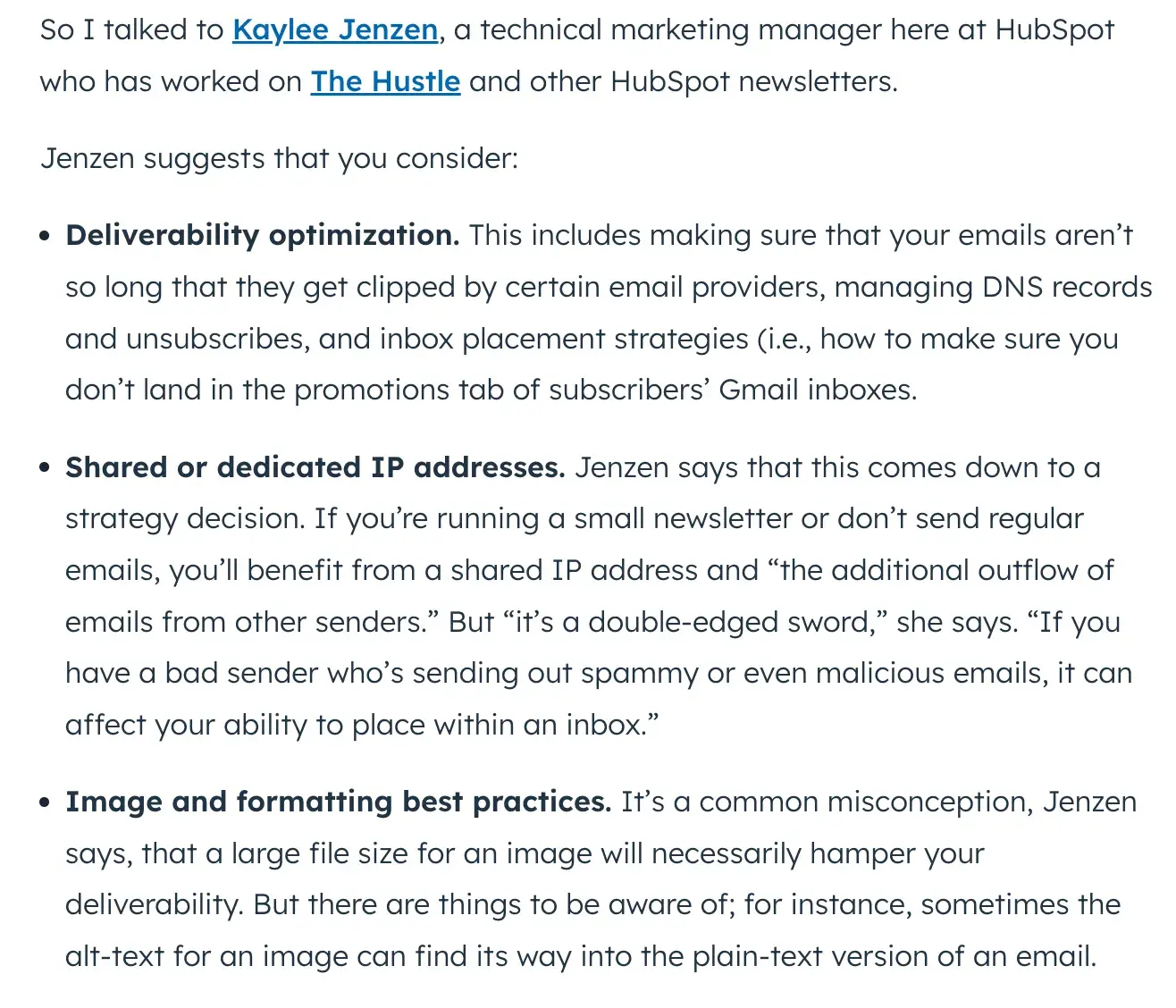
Sometimes you don’t know what you don’t know, and reaching into your own experience can help uncover questions your audience will have as they dive further into the topic at hand.
4. Research the topic and any trends.
If you have access to a data and research tool like Statista, IBISWorld, or similar, get in the habit of running a few searches. This didn’t turn out to be a major source for this particular topic, but I did find some data on personalization, which was one of the subtopics I touched on in the blog post.
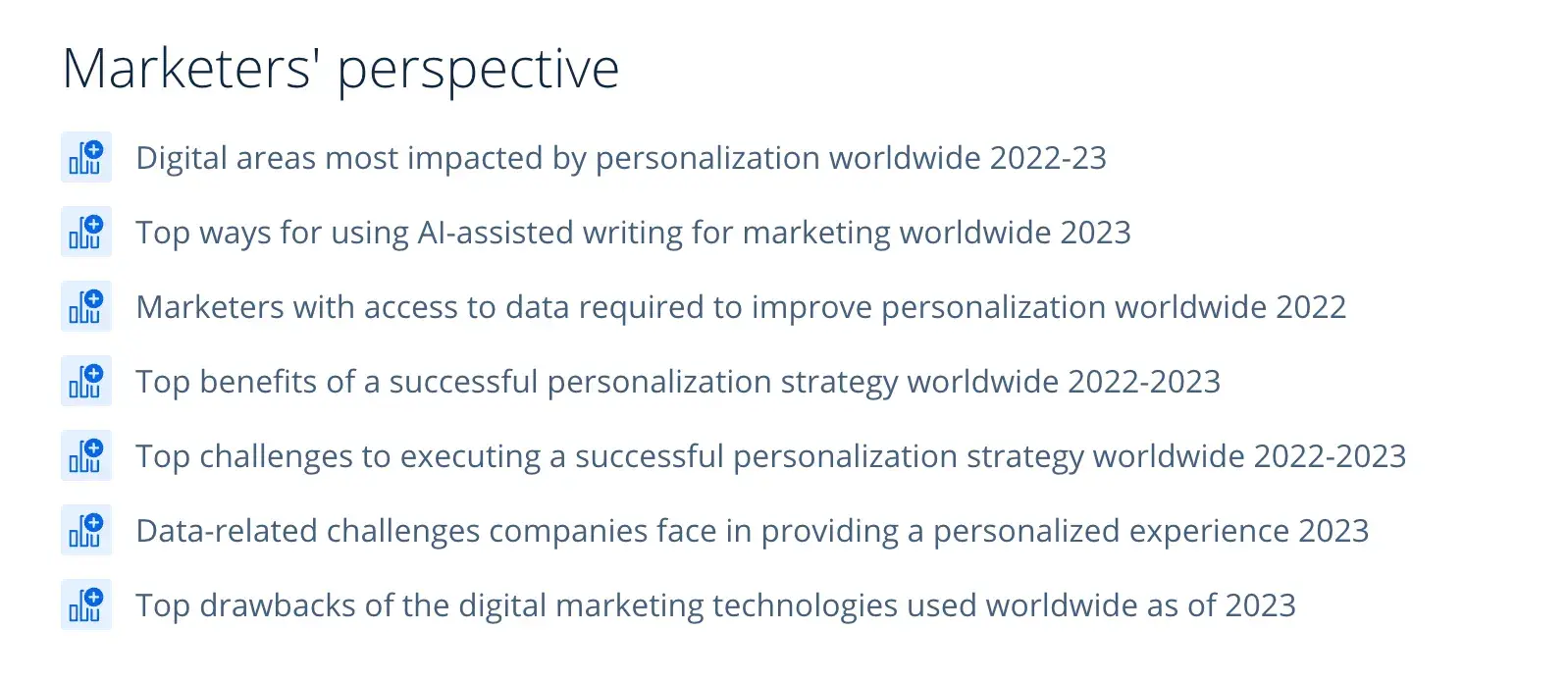
I also searched Google Scholar for “email newsletters in marketing,” restricting results to anything from 2023 or later. I came across a December 2023 paper entitled “Personalization (In)effectiveness in email marketing” from a journal called Digital Business.
This ended up being a background resource for me rather than something I quoted in my article, but in my opinion, it’s worth taking a few minutes to check scholarly journals — you never know when you’ll come across somebody doing something brand new in the field.
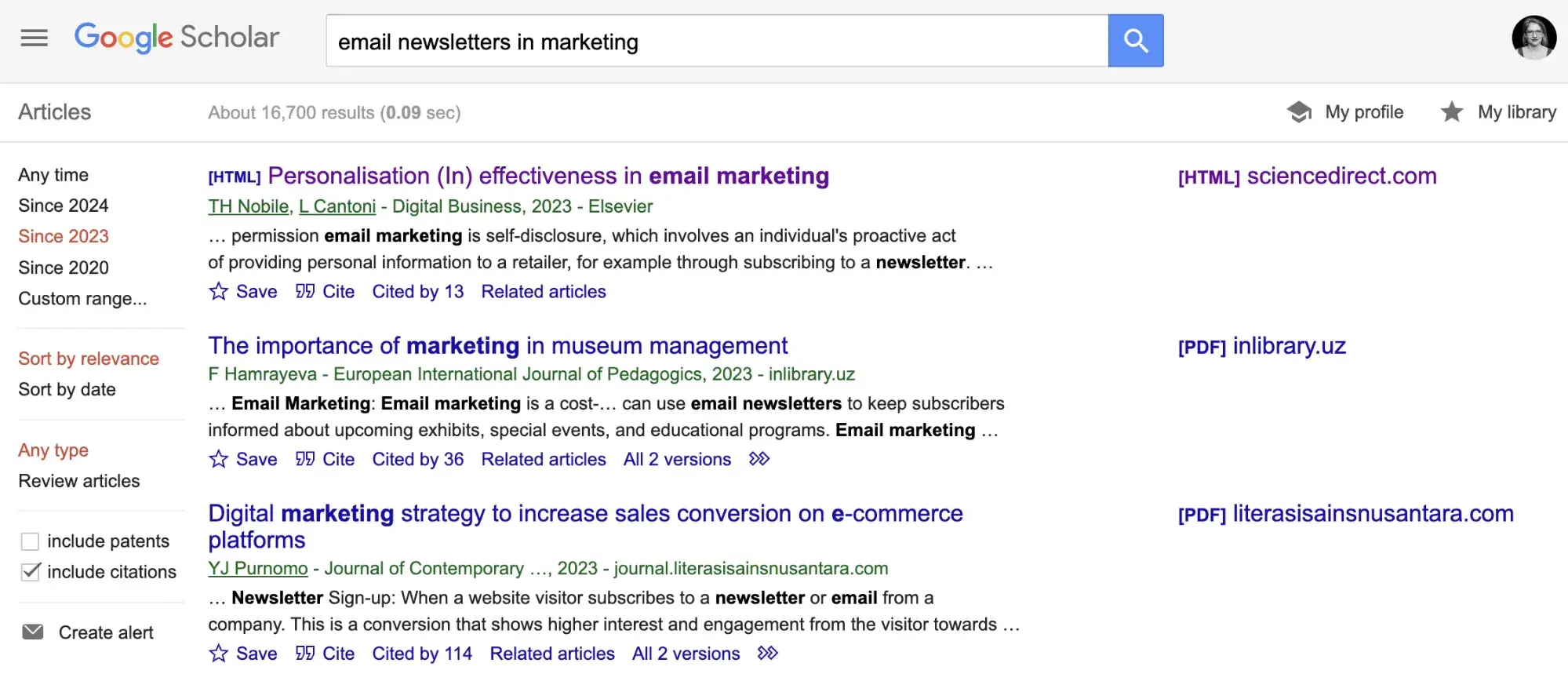
5. Interview subject-matter experts.
This step can be intimidating if you don’t know subject-matter experts. Here’s a few of my tricks I used to find people to talk to about B2B newsletters:
- I started by asking the HubSpot #marketing Slack channel: What are your favorite email newsletters? Lia Haberman’s ICYMI and Alexis Grant’s They Got Acquired were both mentioned several times, so they went on my list.
- I searched LinkedIn for “B2B email marketing” and found other experts and top voices.
- I went through my own network and found that I knew a few people on the technical side. I asked them if they had any suggestions and recommendations.
- I asked other newsletter writers at HubSpot if I could talk to them, and if they knew anybody they could introduce me to.
6. Analyze the performance.
It’s good to check the performance of your piece after a month, though I’ve also worked in places where we monitored daily performance — so let your industry and KPIs guide you. If you’re writing timely (as opposed to evergreen) content, your pageviews will probably peak within the first week or even sooner.
If you use HubSpot CMS, clicking “view post details” will let you monitor metrics like lead conversion rates, revenue attributed, and other metrics. HubSpot also shows you the breakdown of traffic sources, which can help you fine-tune your distribution in the future. (Google Analytics, a commonly used tool, has similar metrics.)

Research With Confidence
There are many approaches to content research, and not everything I’ve outlined may apply to you. But you should now have a solid foundation for content research, the many paths it can take, and how to effectively and efficiently start researching great content.
![]()


